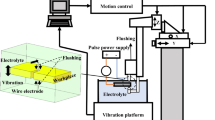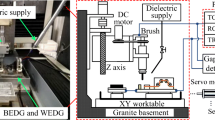Abstract
Gear involute artifact (GIA) is an indispensable tool in the detection of high-precision gears. In this paper, a new method of horizontal electrode wire electrochemical contour evolution machining (HE-WECEM) was proposed to machine GIA. Compared with traditional circular interpolation for machining involute, HE-WECEM simulates the evolving process of involute to greatly improve the machining accuracy. Firstly, the machining mechanism of GIA by HE-WECEM was studied through mathematical models and electric field simulations. Secondly, reciprocating feed and two-way flushing fluid system was used, and its effectiveness in updating the electrolyte in the machining slit was analyzed through a flow-field simulation. And then, comparative experiment was designed to further validate the effectiveness of the flushing fluid system. The results indicate that the flushing system can effectively improve the stability of HE-WECEM. Finally, single-factor experiments were designed to investigate the effects of electrical parameters on machining. Based on the single-factor experiments, the Box–Behnken experiment was conducted on the electrical parameters. The response surface methodology (RSM) was used to analyze the composite effects of electrical parameters and obtain the optimal combination of machining parameters. A GIA blank with base circle radius of 50 mm was fabricated on an 8-mm-thick GCr15 workpiece, and the maximum deviation of tooth profile can reach 17.18 μm. The average surface roughness Sa reaches 1.435 μm. It is proved that HE-WECEM is a reliable method for machining GIA blank.
























Similar content being viewed by others
Data availability
All data generated or analyzed during this study are included within the article.
References
Frazer RC, Bicker R, Cox B, Harary H, Härtig F (2004) An international comparison of involute gear profile and helix measurement. Metrologia 41:12–16
Ling SY, Lou ZF, Wang LD (2013) Optimal forming principle and grinding experiment of the ultra-precision involute profile. P I Mech Eng B-J Eng 227:375–382
Ling M, Ling SY, Yu DQ, Wang FT, Shi ZY, Wang LD (2023) Adjustment for profile deviations of gear involute artefacts. Meas Sci Technol 34:055016
Takeoka F, Komori M, Kubo A (2008) Design of laser interferometric measuring device of involute profile. J Mech Des 130:052602
Chen HF, Liang CW, Shi ZY, Xu H, Wei TS, Lin H, Xie HK (2022) New design method for large involute artifacts. Precis Eng 76:190–198
Li LX, Liu Y, Ling SY, Wang K, Li CX (2023) Theoretical and experimental study on LV-WECM of gear involute artifact with high aspect ratio. Int J Adv Manuf Technol 124:3453–3469
Ling M, Ling SY, Li XY, Shi ZY, Wang LD (2022) Effect on the measurement for gear involute profile caused by the error of probe position. Meas Sci Technol 33:115013
Tang J, Wei J, Shi Z (2019) An evaluation method of gear profile deviations based on the consideration of installation errors. Measurement 146:806–814
Kondo Y, Sasajima K, Noguchi S, Kondo K, Osawa S, Naoi K, Takatsuji T (2008) Tooth form evaluation using ball artifact development of a measuring instrument of a ball center distance traceable to national standard of length. Key Eng Mater 381-382:595–598
Komori M, Takeoka F, Kondo K (2010) Design method of double ball artifact for use in evaluating the accuracy of a gear-measuring instrument. J Mech Des 132:071010
Takeoka F, Komori M, Kubo A (2009) High-precision measurement of an involute artefact by a rolling method and comparison between measuring instruments. Meas Sci Technol 20:45105
Wu XY, Li SJ, Jia Z, Xin B, Yin XC (2019) Using WECM to remove the recast layer and reduce the surface roughness of WEDM surface. J Mater Process Technol 268:140–148
Fang XL, Yang T, Chen M, Zhu D (2020) Fabrication of a large-aspect-ratio single-thread helical electrode using multiple wire electrochemical micromachining. Int J Electrochem Sci 15:7796–7808
Tang C, Han Z, Zhou ZQ, Fang XL (2023) Precision wire electrochemical machining of thick structures in powder superalloy René 88DT using a partially insulated tube electrode. Adv Manuf. https://doi.org/10.1007/s40436-023-00441-5
Fang XL, Han Z, Chen M, Zhu D (2020) Pulse-current wire electrochemical machining with axial electrolyte flushing along a rotating helical wire tool. J Electrochem Soc 167:113503
Gao CP, Qu NS, Ding B, Shen YZ (2019) An insight into cathodic reactions during wire electrochemical micromachining in aqueous hydrochloric acid solution. Electrochim Acta 295:67–74
Qu NS, Gao CP (2021) Improving surface processing quality in wire electrochemical micromachining by gas bubble chain[J]. J Mater Process Technol 294:117136
Volgin VM, Lyubimov VV, Davydov AD (2016) Modeling and numerical simulation of electrochemical micromachining. Chem Eng Sci 140:252–260
Besekar N, Bhattacharyya B (2022) Experimental investigation and characterization of NiTinol shape memory alloy during wire electrochemical machining. J Manuf Process 81:346–361
Tyagi A, Sharma V, Jain VK, Ramkumar J (2018) Investigations into side gap in wire electrochemical micromachining (wire-ECMM). Int J Adv Manuf Technol 94:4469–4478
Sharma V, Srivastava I, Jain VK, Ramkumar J (2019) Modelling of wire electrochemical micromachining (wire-ECMM) process for anode shape prediction using finite element method. Electrochim Acta 312:329–341
Besekar N, Bhattacharyya B (2022) Wire electrode insulation method for stray current and overcut reduction during WECM—a novel approach. Int J Adv Manuf Technol 123:3917–3942
Sharma V, Patel DS, Agrawal V, Jain VK, Ramkumar J (2021) Investigations into machining accuracy and quality in wire electrochemical micromachining under sinusoidal and triangular voltage pulse condition. J Manuf Process 62:348–367
Debnath S, Kundu J, Bhattacharyya B (2018) Modeling and Influence of voltage and duty ratio on wire feed in WECM: possible alternative of WEDM. J Electrochem Soc 165:E35–E44
Chen XL, Zhu JJ, Xu ZZ, Su GK (2021) Modeling and experimental research on the evolution process of micro through-slit array generated with masked jet electrochemical machining. J Mater Process Technol 298:117304
Funding
Authors acknowledge financial support from the National Key R&D Program of China (No. 2018YFB2001400), the Natural Science Foundation of Shandong Province (No. ZR2021ME048) and the Guangdong Provincial University Innovation Team Project (No. 2020KCXTD012). This work is supported by Physical-Chemical Materials Analytical & Testing Center of Shandong University at Weihai.
Author information
Authors and Affiliations
Contributions
Xiaotong Wu performed the experiment, contributed significantly to analysis and manuscript preparation, performed the data analyses, and wrote the manuscript; Yong Liu contributed to the conception of the study and edited the manuscript; others helped perform the analysis with constructive discussions.
Corresponding author
Ethics declarations
Ethics approval
Compliance with ethical standards.
Consent to participate
All authors agreed with the consent to participate.
Consent for publication
All authors have read and agreed to the publication of the paper.
Competing interests
The authors declare no competing interests.
Additional information
Publisher’s Note
Springer Nature remains neutral with regard to jurisdictional claims in published maps and institutional affiliations.
Rights and permissions
Springer Nature or its licensor (e.g. a society or other partner) holds exclusive rights to this article under a publishing agreement with the author(s) or other rightsholder(s); author self-archiving of the accepted manuscript version of this article is solely governed by the terms of such publishing agreement and applicable law.
About this article
Cite this article
Wu, X., Ling, S., Li, C. et al. Wire electrochemical contour evolution machining of gear involute artifact with horizontal electrode. Int J Adv Manuf Technol 129, 3577–3594 (2023). https://doi.org/10.1007/s00170-023-12559-8
Received:
Accepted:
Published:
Issue Date:
DOI: https://doi.org/10.1007/s00170-023-12559-8




